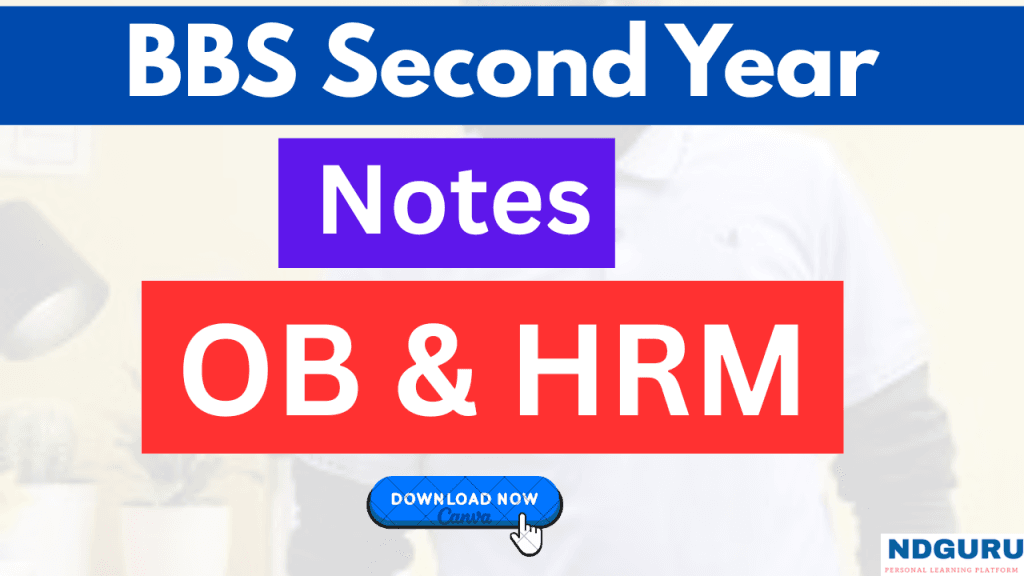Welcome to the ultimate resource for BBS 2nd Year OB and HRM Notes! If you’re a Bachelor of Business Studies (BBS) student under Tribhuvan University (TU) in Nepal, preparing for your 2082 exams can be overwhelming with scattered resources. This comprehensive guide covers the full syllabus, chapter-wise summaries, key concepts, and exam tips—all in one place.
Download OBHRM NotesWhether you’re studying Organizational Behavior (focusing on individual and group dynamics in workplaces) or Human Resource Management (strategies for managing talent and performance), we’ve got you covered. Downloadable PDFs, quick quizzes, and real-world examples make this your go-to study companion.
Why these notes? Based on the official TU syllabus, they’re concise, exam-oriented, and include past questions. Let’s dive in!
(Image: BBS 2nd Year OB and HRM Notes Cover for TU 2082, Alt Text: BBS 2nd Year OB and HRM Notes Cover for TU 2082)
Part 1: Organizational Behavior (OB) Notes
OB explores how people behave in organizations, influencing productivity, motivation, and culture. Key themes: perception, personality, groups, conflict, and change. Aligned with TU’s 2082 syllabus for Nepal’s diverse workplaces.
Chapter 1: Introduction to Organizational Behavior
- Definition: OB is the study of human behavior in organizational settings, drawing from psychology, sociology, and anthropology.
- Importance: Improves employee satisfaction, reduces turnover, and boosts performance in Nepali SMEs.
- Models of OB: Autocratic (power-based), Custodial (economic security), Supportive (leadership-focused), Collegial (teamwork-oriented).
- Key Contributors: Hawthorne Studies (Elton Mayo) – showed social factors affect productivity.
- Exam Tip: Expect 5-mark questions on OB levels (individual, group, organization). Link to BBS 1st Year Psychology Notes for basics.
Chapter 2: Perception and Learning
- Perception: Process of interpreting sensory information. Factors: perceiver, target, situation. Errors: Stereotyping, halo effect.
- Learning: Permanent change in behavior from experience. Principles: Law of Effect, Classical Conditioning (Pavlov).
- Quick Quiz: What is the difference between perception and attribution? (Answer: Perception interprets; attribution assigns causes.)
Chapter 3: Personality
- Definition: Stable patterns of behavior, thoughts, and emotions.
- Theories: Trait Theory (Big Five: Openness, Conscientiousness, Extraversion, Agreeableness, Neuroticism).
- Exam Tip: Diagram the Big Five for 10-mark questions.
Chapter 4: Job Satisfaction
- Factors: Pay, promotion (Herzberg’s Two-Factor Theory: Hygiene vs. Motivators).
- Outcomes: High satisfaction → low absenteeism.
- Real-World Example: Google’s perks boost satisfaction—adapt for Nepali firms like Nabil Bank.
Chapter 5: Groups and Teams in Organizations
- Stages: Forming, Storming, Norming, Performing, Adjourning (Tuckman).
- Dynamics: Roles, norms, cohesion.
Chapter 6: Organizational Conflict and Stress
- Types: Functional vs. Dysfunctional. Resolution: Collaboration (Thomas-Kilmann).
- Stress Management: Time management, wellness programs.
Chapter 7: Organizational Change and Development
- Process: Lewin’s Model (Unfreeze, Change, Refreeze).
- OD Interventions: Team building.
- Exam Tip: Case studies on remote work post-COVID in Nepal.

Part 2: Human Resource Management (HRM) Notes
HRM focuses on acquiring, developing, and retaining talent. Strategic for TU’s emphasis on ethical practices in Nepal.
Chapter 1: Introduction to Human Resource Management
- Definition: Systematic approach to managing people.
- Functions: Planning, Recruitment, Training.
Chapter 2: Job Design and Analysis
- Job Analysis: Methods: Observation, Interviews.
- Design Approaches: Job Enrichment (Herzberg).
Chapter 3: Talent Acquisition and Development
- Recruitment: Internal vs. External.
- Training: On-the-Job (OJT), Off-the-Job.
- Exam Tip: Flowchart the selection process. See BBS 3rd Year Taxation Notes for related HR compliance.
Chapter 4: Performance Appraisal and Reward Management
- Methods: 360-Degree Feedback, MBO.
- Theories: Equity (Adams).
Chapter 5: Employee Maintenance
- Benefits: Health insurance, work-life balance.
- Labor Relations: Unions in Nepal.
Emerging Issues in HRM
- Diversity, Remote Work, AI in Recruitment, Gig Economy in Nepal.
Exam Preparation Tips for BBS 2nd Year OB and HRM
- Syllabus Alignment: Covers TU’s 100-mark paper (70 theory + 30 internal).
- Question Patterns: Short notes (5 marks), Long answers (10 marks).
- Past Papers: Focus on 2079/80 trends—practical applications.
- Study Schedule: 2 hours/day per chapter; revise with mind maps.
- Resources: Pair with Robbins (OB) and Dessler (HRM). Explore CollegeNP for more TU insights.
Download Full Notes PDF
Related Posts
- BBS 1st Year Business Communication Notes PDF
- Class 12 Re-Exam Accountancy Question Solution 2082
- Class 12 Education & Development Notes NEB 2082
Frequently Asked Questions (FAQ) on BBS 2nd Year OB and HRM Notes
Q: What is the focus keyphrase for these notes? A: The primary focus is bbs 2nd year ob and hrm notes for TU 2082, covering all chapters with exam-ready content.
Q: Are these notes updated for the 2082 syllabus? A: Yes, fully aligned with Tribhuvan University’s latest BBS 2nd Year OB and HRM syllabus for Nepal students.
Q: How can I download the PDF? A: Click the download link above—it’s free! If issues, contact us via WhatsApp: 9745862965.
Q: What if I need solved model questions? A: Our PDF includes 20+ solved questions. For more, join our Facebook group.
Q: Do you offer online classes for OB and HRM? A: Yes! Enroll in NDGURU’s physical/online tuition in Bhaktapur for BBS subjects. Details on our courses page.
Share This Guide
Help your classmates ace their exams! Share this post on:
- Facebook: Spread the word to TU BBS study groups.
- X (Twitter): Tweet with #BBSNotes #TUExam.
- WhatsApp: Share directly with friends (use: https://wa.me/?text=BBS%202nd%20Year%20OB%20and%20HRM%20Notes%20-%20https://nagendradhimal.com.np/bbs-2nd-year-ob-hrm-notes-2082-pdf-tu).
Pro Tip: Share this guide with classmates to build a study group—collaboration is key in OB! If you need clarifications, past questions, or custom quizzes, drop a comment below. Ace your exams and top the class!
Last Updated: September 30, 2025 | Prepared by NDGURU for TU BBS Students | © 2025 NDGURU | All Rights Reserved

